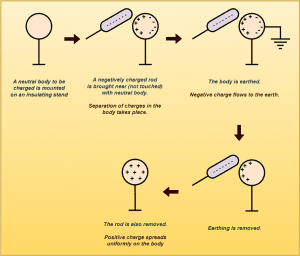Electric Charge-
Before you go through this article, make sure that you have gone through the previous article on Electric Charge. It explains the basic concepts related to related electric charge.
In this article, we will discuss the Methods of Charging.
Electrification-
| The process of developing charge on a body is called as electrification. |
- Ordinarily, matter contains equal number of protons and electrons.
- A body can be charged by the transfer of electrons or redistribution of electrons.
- A body can be charged by the transfer of electrons and not by the transfer of protons.
- It is because protons are inside the nucleus and it is very difficult to remove them from there.
- Electrons lie in the outer shells and it is easier to remove them.
|
To charge a body negatively, some electrons are given to it. To charge a body positively, some electrons are taken from it. |
Methods of Charging-
Basically, charging can be done by three methods-

- Charging by friction
- Charging by conduction
- Charging by induction
1. Charging By Friction-
- When two suitable bodies are rubbed together, electrons are transferred from one body to the other body.
- The body which gains the electrons become negatively charged.
- The other body which loses the electrons become positively charged.
- It depends upon the electropositivity of the two bodies which body gains the electrons and which body loses the electrons.
This method of charging is called as charging by friction.
Electrostatic Series-
- The electrostatic series is a list of materials in order of increasing tendency to gain electrons.
- As we move further down the list, the materials increase in their tendency to gain extra electrons.

Examples-
- When a glass rod is rubbed with silk, the rod becomes positively charged while silk gets negatively charged.
- Ebonite on rubbing with wool becomes negatively charged making the wool positively charged.
- When a plastic comb is run through one’s dry hair, the comb becomes negatively charged while hair gets positively charged.
2. Charging By Conduction-
When a charged body is brought in contact with a neutral body, charge is shared between the two bodies and the neutral body gets charged.
This method of charging is called charging by conduction.

3. Charging By Induction-
- When a charged body is brought near a neutral body without touching, the charged body attracts opposite charge and repels similar charge present on the neutral body.
- If the neutral body is now earthed, the like charge is neutralized by the flow of charge from earth, leaving unlike charge on the body.
- Now, removing the earthing and the charging body, leaves the initially neutral body charged.
This method of charging is called charging by induction.

Charging By Conduction Vs Charging By Induction-
The following table shows the differences between charging by conduction and charging by induction-
Charging By Conduction |
Charging By Induction |
| The process of charging a neutral body by touching a charged body is called charging by conduction. | The process of charging a neutral body without touching a charged body is called charging by induction. |
| It involves the movement / transfer of charge from the charged body to the neutral body. | It does not involve any movement / transfer of charge from the charged body to the neutral body. |
| Some charge is lost by the charging body. | No charge is lost by the charging body. |
| During charging by conduction, both the bodies acquire same type of charge. | During charging by induction, both the bodies acquire different type of charge. |
Mass Transfer During Charging-
In the process of charging, a body either gains or loses electrons to gain either negative or positive charge.
We know that electrons too have mass (me = 9.11 x 10-31 kg). So, the body which gains the electrons, its mass increases and the body which loses the electrons, its mass decreases.
If the charging process involves the transfer of ‘n’ electrons from one body to the other body, then mass transfer due to electrification is given by-

Read the next article on-
Coulomb’s Law | Definition | Formula | Examples
Get more notes & other study material of the Chapter Electric Charges & Field.

